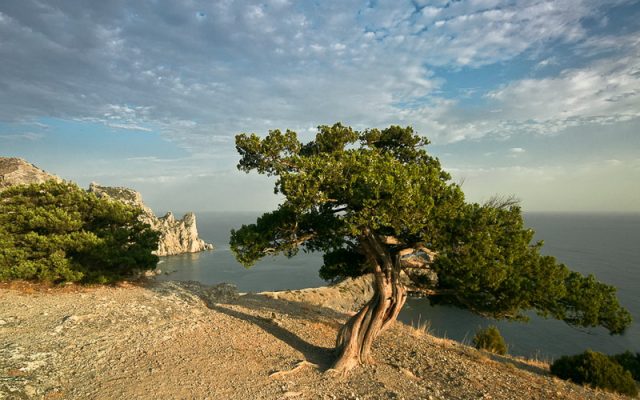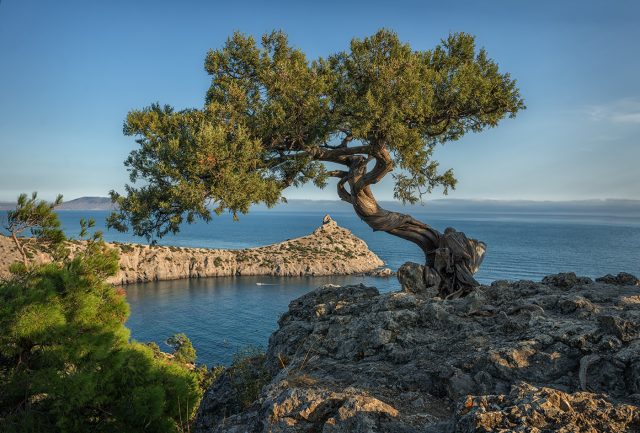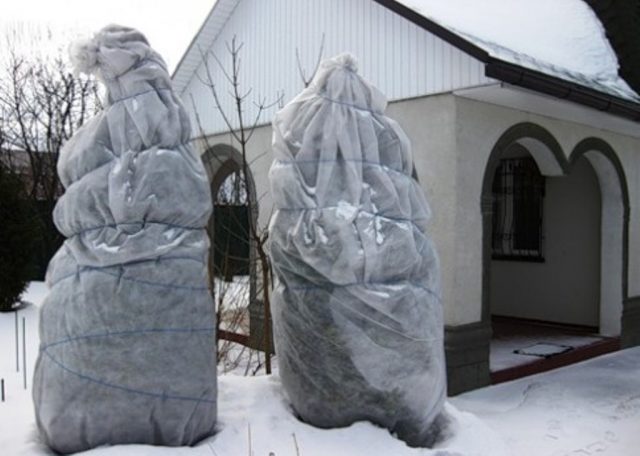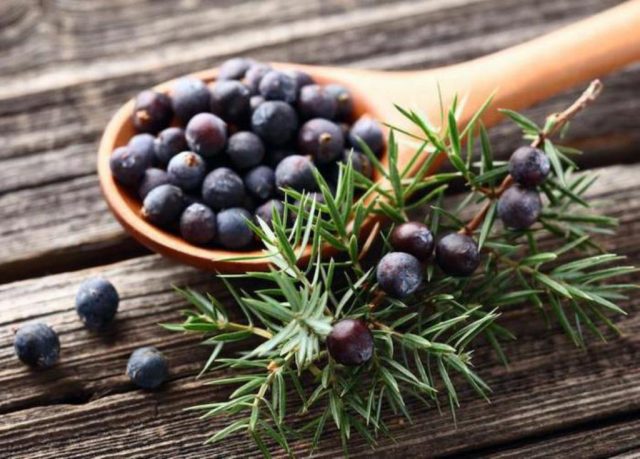Content
The tall juniper is an evergreen plant that has been valued since ancient times for its wood and medicinal properties. Unfortunately, under natural conditions of growth, the species is less and less common, so it was included in the Red Book. But everyone can grow this mighty tree on a personal plot in all of Russia.
Description of high juniper
The tall juniper belongs to the cypress family, the height of an adult tree is 10-15 m, the trunk diameter is up to 2 m. The young plant forms a pyramidal crown, which becomes spreading with age. Thin rounded-tetrahedral branches are covered with small, numerous leaves of a gray-emerald hue.
The tall juniper is a monoecious tree producing single, spherical fruits up to 12 cm in diameter. The berries are purple-gray with a thick whitish bloom. The plant reproduces by seeds, which are spread over long distances by wind, birds and squirrels. Germination rate is low, is 20%.
A tall juniper is not a fast-growing plant; by the age of 60, the tree reaches only a meter in height. The average age of life in natural conditions is about 600 years. But there are specimens that are more than one and a half thousand years old.
Where tall juniper grows in Russia
In Russia, high juniper can be found in the Crimea, in the Krasnodar Territory, from Anapa to Gelendzhik, in Tuapse. The tree is not afraid of drought, loves rocky hills, mountain belts, starting with surf zones and ending with a half-meter height above sea level. There are individuals that grow at an altitude of 2 km above sea level and even higher.
Why is a tall juniper listed in the Red Book
The tall juniper was listed in the Red Book of the USSR in 1978, now it is in the Red Book of the Russian Federation with the status of "Vulnerable species".
The tall juniper is listed in the Red Book of Russia, as its population is rapidly exterminating. Reasons for the disappearance of high juniper:
- felling due to valuable wood: for the manufacture of furniture, souvenirs and handicrafts;
- resort buildings;
- the progression of agricultural activities;
- for use in technical and essential oil industries.
Great losses in numbers were inflicted during the Second World War and during the construction of the Abrau-Dyurso road.
If everyone adheres to these simple rules, the population of this beautiful, medicinal tree will increase, and the air on the planet will become cleaner and more transparent.
Interesting facts about tall juniper
The tall juniper has been known since antiquity and has been captured in myths and legends:
- With the help of a fragrant tree, which has sleeping pills, Jason and Medea euthanized the snake that guarded the Golden Fleece in Colchis, thereby completing their mission.
- A smell emanates from the needles, which cures many diseases, since this tree purifies the air much better than other conifers. Thanks to the healing aroma, the ancestors fumigated the room where the seriously ill were, and the Ancient Romans got rid of the cholera outbreak.
- Juniper is a leader among conifers in the content of bactericidal essential oils. A hectare of juniper forest is capable of disinfecting the air in a large metropolis.
- Juniper wood is highly rot-resistant. It was used to build basement floors in the famous Genoese fortress in Sudak. Over the 700-year history, the columns of wood did not fail and steadfastly hold 3 floors, while the stone walls of the tower need reconstruction for a long time.
Planting and caring for high juniper
Despite the fact that the juniper is tall - a heat-loving plant, its frost resistance is high, it can withstand up to - 23 ° C. Therefore, everyone can plant a tree on their personal plot. But before purchasing a high juniper seedling, you need to view the photo and read the description.
High juniper propagates by seeds and cuttings. Since seed germination is low, cuttings are often used:
- Cuttings are cut in June from the top of the crown, up to 15 cm in size.
- Remove the lower needles and peel off the stem.
- The prepared stalk is kept in the "Kornevin" preparation and buried at an acute angle into the nutrient soil.
- For quick rooting, make a microstep.
- After rooting, the plant is planted in a lighted place in a nutritious soil.
To grow a beautiful plant, timely care must be observed, which consists in watering and feeding.
After watering, loosening is carried out, removal weeds and mulching. The mulch will help to retain moisture and be an additional organic fertilizer.
In the spring, nitrogenous fertilizing can be added for growth and development. In the fall, phosphorus-potassium fertilizers are applied to better endure the cold winter.
Juniper does not need pruning. It is carried out only to give the crown a decorative look or to create a green hedge. A tall juniper needs regular sanitary pruning. To do this, it is necessary to promptly remove dry, frozen and infected branches.
High juniper - cold-resistant species, can overwinter at a temperature of -23 ° C. Young seedlings and trees growing in harsh climatic conditions need shelter. To save the tree from the cold, you need to carry out simple measures:
- The land is abundantly shed, fed and mulched.
- The crown is tied from bottom to top with twine in a spiral.
- Close with spruce branches and cover with breathable material.
Diseases and pests
Unlike other conifers, tall juniper often suffers from the following diseases:
- Rust - a common disease caused by a fungus. The disease appears in early summer due to heavy rains and low air temperatures. Rust can be recognized by the slightly raised orange spots that appear on the needles and petioles. Without treatment, the spots crack and spores of fungi appear from them, which are quickly transferred to neighboring plants with the wind. As a struggle, the drug "Arcerida" is used, which must be applied every 10 days until complete recovery.Important! If you are late with treatment, the plant will have to be dug up and disposed of.
- Schütte - mainly the disease affects young plantings in wet weather and with a thickened planting. In a diseased plant, the color of the needles changes, which eventually dies and falls off. To prevent the disease from progressing, it is necessary to remove fallen needles in a timely manner, remove and burn damaged needles. For the prevention of disease in the spring, juniper is treated with Bordeaux liquid.
- Alternaria - a fungus that affects the root system, as a result of which the needles turn dark brown, the bark becomes covered with a dark bloom. The disease often appears due to a thickened planting.To combat the fungus, damaged branches are removed, treated with Bordeaux liquid, the wounds on the branches are treated with copper sulfate and covered with garden pitch.
Juniper high in medicine
The high juniper is widely used in folk medicine. Since it has a diuretic, sedative, expectorant effect, it treats diseases of the digestive tract, skin diseases and is used in cosmetology.
One of the oldest and most effective methods is the fresh berry treatment. For 30 days of regular intake, they cleanse the blood, strengthen the immune system, relieve swelling and lower blood pressure.
It is necessary to consume juniper berries on an empty stomach and strictly according to the instructions:
- the first day - 1 berry;
- before day 15, the number of berries is increased to 15 pcs.;
- further, the dose is reduced by 1 berry daily.
Recipes known since ancient times
The healing properties of juniper make it possible to use it in traditional medicine recipes:
- Decoction... It is used as a diuretic and choleretic agent. 1 tsp pour 250 ml of water and boil for 5 minutes. The finished broth is left for 25 minutes for infusion, filtered in the morning, afternoon and evening for 1 tbsp. l. before eating.
- Juniper tincture... An effective remedy for getting rid of rheumatism, arthritis, arthrosis. The berries are poured with 70% alcohol in a ratio of 1:10. The tincture is removed to a dark place and insisted in a warm place for at least a week.
- Juniper oil promotes hair growth and strengthening. The mask with the addition of oil smoothes the skin, relieves acne and acne, makes the skin firm and elastic.
Despite its beneficial qualities, juniper can be harmful to the body. It is not recommended in the following cases:
- pregnant and lactating women;
- with hepatic and renal failure;
- people with individual intolerance;
- with a gastrointestinal tract disease in the acute stage;
- with diabetes.
Conclusion
The tall juniper is a rare, healing, evergreen tree that can be found not only in wildlife, but also grown on a personal plot. The plant is unpretentious, slow-growing and, subject to the rules of care, will be an excellent addition to landscape design.












